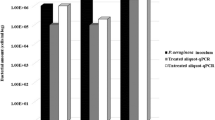Abstract
The overgrowth of normal flora escaping the action of sputum processing chemicals is the major problem in broth-based tuberculosis (TB) detection systems. The use of phages to control the overgrowth of normal flora in processed sputum samples has already been established. Phage lysin and its supplementation to phagebiotics for the effective control of normal flora in sputum specimens were evaluated. Crude lysin was prepared from phage host mixture using standard procedures. About 120 sputum samples processed with 4% NaOH were collected and used to evaluate the effect of lysin, phagebiotics and phagebiotics supplemented with lysin on the overgrowth of normal flora. The effect of phagebiotics and lysin on the growth and retrieval of Mycobacterium tuberculosis was studied by conventional methods and the luciferase reporter phage (LRP) assay. Lysin alone and phagebiotics supplemented with lysin arrested the growth of normal flora in a significantly greater number of samples than phagebiotics alone. Lysin and phagebiotics did not show any inhibitory activity on M. tuberculosis. The use of antibiotics can be replaced by lysin or phagebiotics supplemented with lysin to control the overgrowth of normal flora in processed sputum samples without hampering the viability of M. tuberculosis.


Similar content being viewed by others
References
Kent PT, Kubica GP (1985) Public health mycobacteriology: a guide for the level III laboratory. US Department of Health and Human Services, Public Health Service/Centers for Disease Control, Atlanta, GA, p 30333
Conville PS, Andrews JW, Witebsky FG (1995) Effect of PANTA on growth of Mycobacterium kansasii in BACTEC 12B medium. J Clin Microbiol 33:2012–2015
Fischetti VA (2006) Using phage lytic enzymes to control pathogenic bacteria. BMC Oral Health 6(Suppl 1):S16
Borysowski J, Weber-Dabrowska B, Górski A (2006) Bacteriophage endolysins as a novel class of antibacterial agents. Exp Biol Med (Maywood) 231:366–377
Cohen JO, Gross H, Harrell WK (1975) Simple procedure for production by group C streptococci of phage-associated lysin active against group A streptococci. Appl Microbiol 29:175–178
Nelson D, Loomis L, Fischetti VA (2001) Prevention and elimination of upper respiratory colonization of mice by group A streptococci by using a bacteriophage lytic enzyme. Proc Natl Acad Sci USA 98:4107–4112
Loeffler JM, Nelson D, Fischetti VA (2001) Rapid killing of Streptococcus pneumoniae with a bacteriophage cell wall hydrolase. Science 294:2170–2172
Schuch R, Nelson D, Fischetti VA (2002) A bacteriolytic agent that detects and kills Bacillus anthracis. Nature 418:884–889
O’Flaherty S, Coffey A, Meaney W, Fitzgerald GF, Ross RP (2005) The recombinant phage lysin LysK has a broad spectrum of lytic activity against clinically relevant staphylococci, including methicillin-resistant Staphylococcus aureus. J Bacteriol 187:7161–7164
Pritchard DG, Dong S, Baker JR, Engler JA (2004) The bifunctional peptidoglycan lysin of Streptococcus agalactiae bacteriophage B30. Microbiology 150:2079–2087
Payne K, Sun Q, Sacchettini J, Hatfull GF (2009) Mycobacteriophage Lysin B is a novel mycolylarabinogalactan esterase. Mol Microbiol 73:367–381
Hoopes JT, Stark CJ, Kim HA, Sussman DJ, Donovan DM, Nelson DC (2009) Use of a bacteriophage lysin, PlyC, as an enzyme disinfectant against Streptococcus equi. Appl Environ Microbiol 75:1388–1394
Zimmer M, Vukov N, Scherer S, Loessner MJ (2002) The murein hydrolase of the bacteriophage phi3626 dual lysis system is active against all tested Clostridium perfringens strains. Appl Environ Microbiol 68:5311–5317
Düring K, Porsch P, Fladung M, Lörz H (1993) Transgenic potato plants resistant to the phytopathogenic bacterium Erwinia carotovora. Plant J 3(4):587–598
Acknowledgements
Balaji Subramanyam acknowledges the financial support from the Indian Council of Medical Research, New Delhi, India.
The authors acknowledge the statistical assistance of Ms. M. Vasantha, Department of Statistics, Tuberculosis Research Centre, Chennai, India.
Author information
Authors and Affiliations
Corresponding author
Rights and permissions
About this article
Cite this article
Subramanyam, B., Kumar, V., Perumal, V. et al. Phage lysin to supplement phagebiotics to decontaminate processed sputum specimens. Eur J Clin Microbiol Infect Dis 29, 1407–1412 (2010). https://doi.org/10.1007/s10096-010-1018-8
Received:
Accepted:
Published:
Issue Date:
DOI: https://doi.org/10.1007/s10096-010-1018-8




